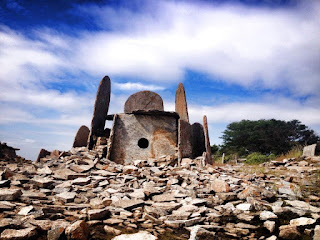Dolmens, cairn circles, hero stones are megalithic burial sites seen all over Tamilnadu. Dolmens go by various names like Vaaliyaar veedu, kurakku pattadai, Pancha Paandavar padukkai and more popularly as veerakkal or nadukal. Often personal effects of the buried are also found in small pots with the sarcophagus.
 |
| Megalithic cairn circle, Tirupporur Photo : VSS Iyer |
 |
| Dolmen 1 photo: Sukavana Murugan |
 |
| Dolmen 2 photo: Sukavana Murugan |
While
usually dated to 7th and 8th centuries BC, some have been dated to as late as the fifth
century AD.
Tolkappiyam
lists six stages in planting a memorial stone – nadukal
- Selection of suitable stone
- Quarrying it
- Soaking it in water
- Planting and consecrating after carving the image
- Offerings
- Prayers
Other
texts list similar stages, but include a final stage where a King or Chieftan
builds a temple over the planted stone. These are also listed as kaatchi kaadhai, kalkoL kaadhai, neerpadaik
kaadhai, nadukar kaadhai and vaazhthu
kaadhai in Silappadikaram.
A
Purananuru poem on the death of Kopperunchola by the poet Pottiyar ends “Let us
sing the glory of our patron who has become a planted stone.”
A burial
urn was made for Nedumavalavan, and a poem addresses a potter that to make his
urn, “the whole world should be used as a wheel, and lofty mountain as a lump
of clay, suited to his fame.”
 |
| Burial urn, Adichanallur, Tamilnadu Inscriptions Exhibit, Madras University |
A poem
of Avvaiyaar on the death of Athiyaman Neduman Anji says a Nadukal was erected
for him. It was decorated with peacock feathers and liquor was sprinkled
Nagaswamy
connects these customs with current Hindu cremation ceremonies. He cites the
contemporary funeral of a Brahmin woman, after whose death two stones were
planted, one on the bank of a river, another at the entrance to the house of
the deceased; called nadi-theera-kuNDa and gruha-theera-kuNDa respectively.
Water was sprinkled over the stone with a towel (vasa udaka) and sesame seeds (
tilodaka ) offered. A potful of drinking water was placed over the stones.A
lamp was kept burning throughout. This Vedic ceremony strongly resembles the
ceremonies for Athiyaman sung by Avvaiyaar.
The very
large number of dolmens and hero stones suggest that these were for all classes
of people, including women, in the ancient times. Later this was limited to men
of valour and fame.
Bodhyana,
Katyayana, and the Vaikhanasa Sutra describe procedures for burial of dead or
their ashes. Udayana’s elephant Badraapati which fell in war, was honored by a
life size stucco image in a temple and regular worship was arranged, as related
in Perunkadai.
In later times Raja Raja built a colony of housing for dancers around the Big temple. A colony of dancers was established around the temple, Brahmins were fed monthly and a water shed erected for travelers. There were arrangement for exposition of kaavya-s and puraaNa-s. This shows that deification of dead and customs to commemorate them were universalised.
Photo Credits
Dolmens: Sukavana Murugan, Pennar archaeological forum, Krishnagiri
Burial urns : Inscriptions Exhibit, University of Madras
Cairn circle : VSS Iyer
------------
This essay is one of a series of summaries of papers presented in international seminars by Dr Nagaswamy. The summaries in this series were presented by me at a lecture titled Nagaswamy - Beyond Borders at Tamil Heritage Trusts' Pechu Kacheri 2014 at Tatvaloka, Chennai.
My blogs on history
My blogs on art
No comments:
Post a Comment